Violence, citizenship and virility: The making of an irish fascist
Published in 20th-century / Contemporary History, Features, Issue 6 (Nov/Dec 2005), Volume 13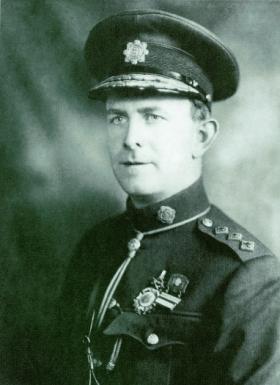
Eoin O’Duffy c. mid-1920s—one of the many portraits to appear in Garda periodicals. (National Library of Ireland)
Gael, revolutionary, soldier, chief of police, founding president of Fine Gael: during his short and controversial public life General Eoin O’Duffy played many roles. His place in the public memory, however, is largely bound up with just one of them: fascist. O’Duffy’s decision to lead the Blueshirt movement after his removal as commissioner of the Garda Síochána by President de Valera in 1933, and his ill-fated intervention in the Spanish Civil War on the side of General Franco, ensured his legacy as one of the villains of modern Irish history. Perhaps all political lives end in failure, but few careers in Irish public life have ended so ignominiously. The shadow of failure, as one of his acolytes recalled, hung heavily over O’Duffy’s final years of ill-health and tarnished reputation: ‘he was really a pathetic and lonely figure at the end; a recluse in the midst of society’. When he died in 1944—a broken man aged only in his mid-fifties—his obituary in the Irish Times noted that his name had ‘ceased to mean much to the public’.
One of the Irish Free State’s most admired public figures
The general’s life has inevitably been interpreted through the prism of his final decade of failure, but had events taken another course he would have been remembered very differently. Had he managed to avoid dismissal by de Valera, he would have remained—and been remembered as—a rather more formidable figure: the commissioner who guided the police, and the state, through a dangerous political transition in 1932. Or had he, as some of his friends advised, spurned the political career for which he was so unsuited, he would have secured a sympathetic legacy as a dutiful servant of the nation who was harshly sacrificed in the greater interests of the state.
In retrospect, the early 1930s can be seen as the critical period of transformation. To many observers at this time, General O’Duffy remained one of the Irish Free State’s most admired public figures. Since his emergence as the leader of the IRA in Monaghan during the War of Independence, his career had been characterised by success. His organisational and administrative skills had resulted in his appointment as IRA chief of staff by early 1922. During the Civil War he commanded the National Army in the south-west of the country, where the worst fighting occurred. Above all, however, his reputation rested on his performance as commissioner of the Garda Síochána since his appointment in the autumn of 1922.
As commissioner, O’Duffy proved himself not merely a brilliant organiser but an astute propagandist. By emphasising the role of the gardaí as unarmed and apolitical servants of the people, and establishing their patriotic credentials by stressing their devotion to the Irish language, the GAA and Catholicism, he established the legitimacy of his new force, ensuring the success of its efforts to restore order in post-revolutionary Ireland. It was not only as commissioner of this idealistic young force but also as an advocate of the Irish language, a prominent campaigner for temperance, an organiser of the Tailteann games and chief marshal of the International Eucharistic Congress that O’Duffy established himself as a leading crusader for the moral regeneration of the Irish nation. Naturally, not everyone was convinced: he remained a hate figure for anti-treaty republicans such as Mary MacSwiney, who—despite conceding that he was ‘idolised by his men’, ‘considered a model Catholic’ and likely to prove the most popular treatyite candidate for president—suspected ‘that he is playing a very deep game . . . I believe he is extremely unscrupulous’.
Loose cannon
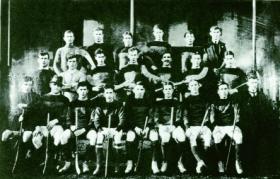
The first known photograph of O’Duffy (extreme right) as a young GAA activist with Monaghan’s 1914 hurling team. (Monaghan County Museum)
Interestingly, by 1931 a number of government ministers had come to share similar reservations. Following a decade in one of the most powerful positions in the state, O’Duffy’s independence had developed into volatile insubordination, his self-confidence into egotism and his flamboyant idealism into a disturbing zeal. He increasingly opposed government policies in public, particularly those that restricted police powers and resources. In private, he harangued the government for its ‘ingratitude and lack of appreciation’ of his efforts, repeatedly warning of his men’s ‘disillusionment and dejection’, and reminding the cabinet that their loyalty to the state was dependent on their treatment by the government. Once the strongest arm in the defence of the state, the general had become a loose cannon, and it was in this period that the Cumann na nGaedheal government resolved to dismiss him if it won re-election.
Where had it all gone wrong? The principal cause of O’Duffy’s disillusionment was the revival of anti-treaty republicanism. The IRA’s campaign of violence against the state, which resumed in November 1926 with coordinated attacks on twelve police stations, immediately exposed tensions between the government and its police commissioner. The revelation that gardaí in Waterford had retaliated against the death of two of their comrades by beating a number of republican prisoners led to O’Duffy’s first serious rift with the minister for justice, Kevin O’Higgins, when the commissioner refused to dismiss the men responsible. The relationship between IRA violence and O’Duffy’s authoritarian tendencies was illustrated three weeks later when he set out his views on coercion in a remarkably frank report. Observing that centuries of British rule had instilled a destructive antipathy to civilised government in the Irish psyche, O’Duffy argued that the revolutionary period had reinforced the idea that armed violence was a relatively safe and effective policy. Church and state were also to blame for this mentality: ‘civics is not taught in the school, citizenship is rarely, if ever, preached in the church, as in other countries’.
Consequently, O’Duffy believed that it fell to the police to teach those who did not practise ‘the duties of citizenship’ that violence does not pay. This, he argued, necessitated the creation of a force ‘capable, not alone of its own defence, but of aggression, real aggression . . . of demanding and insisting on respect for the law of the land, and the extermination of the type that is incapable, or unwilling to assume the responsibilities of citizenship’. He demanded emergency powers to allow him to enforce the values of citizenship upon the state’s recalcitrant population. O’Higgins, backed by the Department of Justice and the cabinet, promptly rejected the proposal, which must have raised doubts about O’Duffy’s suitability for office.
Accused the state of going soft
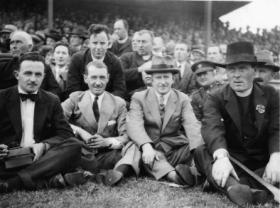
O’Duffy (second left), who throughout his career was always active in the GAA, enjoys a match in the early 1930s. (National Library of Ireland)
By 1931, following five more years of republican violence (which counted O’Higgins among its victims), O’Duffy’s views had hardened. As republicans grew more effective in undermining the courts through intimidation, the judiciary and the public became the most frequent targets of the commissioner’s invective, but an underlying disillusionment with the government and democracy itself also became evident. ‘Weak benches’, he thundered in one report, ‘have brought down states before and they will bring this state down if they persist in their weak-kneed attitude.’ Accusing the state of going soft, he denounced ‘the nonchalance and weakness of the judiciary, the almost contemptuous attitude of people in official positions and the filling of official and semi-official positions with persons who had devoted years—several years—to the destruction of the institutions of the state’. He resented the mounting criticism of police brutality: ‘Maintaining the strict letter of the law is commendable but there is no use worrying over the varnish if the wall is undermined’. But what most frustrated him during this lengthy period of escalating violence was the growing popularity of Fianna Fáil, a party which tacitly condoned IRA violence: ‘Let us make no mistake about it, from the point of view of their outlook on so-called political crime, the Irish public is rotten. Their sense of citizenship is negligible.’
O’Duffy’s response to IRA violence was to intensify coercion. Dubious tactics, such as the physical abuse and repeated arrest of suspects, were sanctioned, but a series of rulings against Special Branch provoked further resentment, leading him to question the need for a conventional judicial system: ‘It is impossible to even surmise what these juries and judges are aiming at; it is certainly an object lesson on the weakness of democratic rule’. In 1931 he demanded permanent legislation to remove constitutional safeguards from republicans, a demand strengthened by a surge of violence in the first part of the year, which resulted in the murder of an IRA informer, a Garda superintendent and a witness. The openness of the republican challenge—particularly the revival of public drilling—unnerved the gardaí, whom, O’Duffy claimed, were close to breaking point.
Red scare
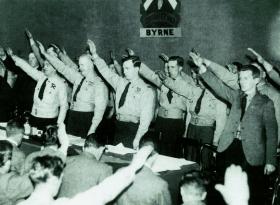
O’Duffy and followers give the raised-arm salute, c. 1933. (National Library of Ireland)
It was at this opportune moment that the discovery of a new republican-backed socialist organisation, Saor Éire, allowed O’Duffy to assert ‘a concrete link’ between the IRA and communism, strengthening his demand for emergency powers. Influenced by security and political considerations—and a certain degree of shared pessimism regarding the flawed character of the population—the government agreed to O’Duffy’s request. Although the red scare reflected genuine concerns, the authorities exaggerated the communist (rather than republican) aspect of the threat to the state in order to win ecclesiastical support for coercion. Assembling what would now be described as a dodgy dossier on the conspiracy, one that deliberately emphasised the threat to ecclesiastical as well as governmental authority, President Cosgrave successfully requested a pastoral from the Catholic bishops in support of the legislation that the Department of Justice and O’Duffy were hurriedly drafting.
The Public Safety Act (1931) contained most of the measures that O’Duffy had demanded, including the establishment of military tribunals with the power to impose the death penalty (thereby removing the weak links of judge and jury) and the power to proclaim organisations and intern subversives. Heartened by the legislation, O’Duffy demanded even greater powers to enforce it in a disturbing memo that illustrated his increasing extremism. He suggested arming all Garda station parties, doubling Special Branch’s personnel, and deploying the force in heavily armed mobile units capable of an ‘offensive campaign against an organisation which refuses to take the field as an army’. He recommended that Colonel Michael Hogan, a serving army officer, lead the reorganised force, which would recruit ‘men who are, on the one hand efficient in the use of lethal weapons and who, on the other hand, would have their heart in such work’. (Having acquired a notorious reputation for torture in Kerry during the Civil War, Hogan would have met both criteria.)
Most disturbingly, O’Duffy argued for the deployment of paramilitary units of army veterans and civilians in the most troubled areas: ‘such local organisations would be a great asset to the recognised forces of the state, as they undoubtedly have been in Northern Ireland’. He also demanded a free hand to crush the IRA without regard to public criticism: ‘these proposals are somewhat extreme. Their justification lies in the fact that the purpose is to deal with extremists—murder gangs—that these people are not entitled to the protection afforded by the Constitution.’ The government did not agree. Such units might have proved effective but would have done little for the stability of the state. The cabinet was only too aware of the need to keep its zealous commissioner on a tight leash. A number of sensitive issues relating to the use of special powers were placed under political rather than police control, and O’Duffy was warned that any ‘unnecessary act of violence by the police or any unnecessary discourtesy will be visited with most severe punishment. The police now have ample powers within the law to deal with political crime.’ As had occurred previously, the coercion act sent the IRA to ground, but it was becoming apparent that Cumann na nGaedheal’s rule was coming to an end.
Canvassed support for a coup d’état
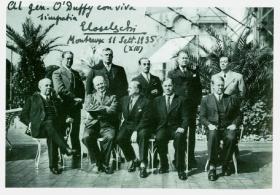
O’Duffy poses with members of the Committee of Action for the Universality of Rome (CAUR), a ‘fascist international’ including the leaders of the Austrian Heimwehr, the Norwegian Nasjonal Samling, Romanian Iron Guard and Spanish Falange, at a meeting in Montreaux in 1935. O’Duffy was appointed to its international secretariat.
It was against this background that O’Duffy began to canvass support among the security forces for a coup d’état. It is not difficult to see how he could rationalise such a move. He had little faith in the government, indeed numerous reasons to resent it, but he regarded the opposition as unfit for power. His reports revealed his lack of respect for the constitution, and a growing belief that the public lacked the civic virtues necessary for democratic rule. By 1931 his optimistic belief in the Garda Síochána’s ability to shape a new moral order had given way to frustration. He was far from alone in his belief that independence had failed to create the nation that his generation had fought for. Many reactionary treatyites attributed this failure to the very experience of revolution and civil war. In his classic polemic, The victory of Sinn Féin, P. S. O’Hegarty observed:
‘We adopted political assassination as a principle; we devised the ambush; we encouraged women to forget their sex and play at gunmen; we turned the whole thoughts and passions of a generation upon blood and revenge and death . . . We derided the moral law, and said there was no other law but force.’
An important aspect of this mindset of despair was the way in which the political degeneration of the nation and the moral decline of society were seen as interconnected. O’Duffy’s pessimism about his country’s future, and his growing belief that only radical measures could redeem it, was bound up with his struggle against anti-treaty republicanism. The experience of fighting a losing battle against republicans, hampered by liberal judges, ungrateful politicians and an increasingly critical public, clearly shaped his trajectory towards fascism. But he had long been concerned about the ‘moral cowardice’ of the population—his first report as commissioner had declared that the ‘people must be saved, almost in spite of themselves’—as was evidenced by his support for campaigns against the ‘drink evil’, ‘filthy literature’, the ‘jazz mania’ and the ‘orgies of dissipation’ that occurred in unregulated dance halls.
Significantly, it was also in 1931—the year of the red scare—that O’Duffy accepted the presidency of the National Athletic and Cycling Association, embarking on a nationwide campaign to revive athletics. This crusade to promote national virility, as he termed it, offers further insights into his concerns. Throughout the next twelve months O’Duffy toured the country endlessly, addressing priests, schoolteachers, sports officials and local politicians. He always stressed the same theme: the necessity for a national renewal to stem the moral and physical degeneration of a population ‘gripped in the lure of modernisation’. He complained of ‘a revulsion from manual work, and a craze for excitement, pleasure and leisure . . . The farms are left deserted for life in the city.’ He warned of the dangers of ‘national decay’ and ‘race deterioration’. He informed a teachers’ conference that ‘Young men are going down the ladder. They are not taking a manly interest in manly sport . . . we are going to be wiped off the map as a nation.’
Although never made explicit, O’Duffy’s concerns about sexual immorality were central to his pessimism. His confidential submission to the Carrigan committee on sexual offences, which detailed the prevalence of rape, incest and child abuse, provided further evidence of his belief in the collapse of the moral order. Crucially, he believed that immorality was responsible for the growth of republicanism and communism, which he saw as products of moral deviancy as much as social or political discontent.
Chain-smoking, alcoholic, homosexual
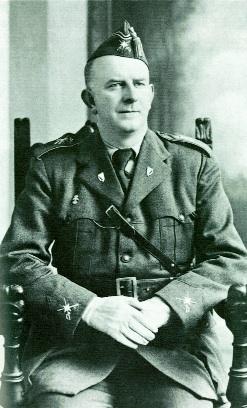
O’Duffy in the uniform of the Irish Brigade, c. 1937. (Monaghan County Museum)
O’Duffy’s fears were also driven by personal concerns. He often spoke of the need to promote the ideal of ‘clean manliness’. Sport, he repeatedly asserted, ‘cultivates in a boy habits of self-control [and] self-denial’ and promotes ‘the cleanest and most wholesome of the instincts of youth’. He invariably spoke of the threat to boys rather than girls, and described it in gendered terms, worrying that ‘the effeminacy so characteristic of the present world [was] finding a way to our shores’. Too many boys, he complained, ‘failed to keep their athleticism, but became weedy youths, smoking too soon, drinking too soon’. In many respects, his preoccupation with the welfare of adolescent males resembled that of his contemporary Robert Baden-Powell, with whom he shared many similarities. The founder of the world’s greatest youth movement also dedicated himself to the propagation of ‘clean manliness’, an attribute closely bound up with patriotism and physical fitness. There can be little doubt that Baden-Powell’s popular rhetoric—‘We badly need some training in our race instead of lapsing into a nation of soft, sloppy cigarette smokers’—influenced O’Duffy. While acknowledging the prevailing discourses of the era, Baden-Powell’s biographer, Tim Jeal, has persuasively attributed this obsession with the promotion of self-control among adolescent males to the sublimation of his own repressed homosexuality. In this context, it comes as no great surprise that the most outspoken nemesis of smoking, drinking and effeminacy in adolescent Irish males was a chain-smoking, alcoholic homosexual. O’Duffy fits a well-established profile, one shared by numerous zealots who project their own internal chaos onto a deviant population in need of redemption.
But although O’Duffy’s remarkable campaign was partly driven by personal compulsions, he was also a man of his time. In expressing such moral, cultural and political anxieties—and turning to culture as a potential solution—he was reflecting discourses that were firmly established in both the Irish republican tradition and interwar Europe. Like his contemporary J. Edgar Hoover, one of the reasons for O’Duffy’s successful career was his ability to exploit the fears of the people while identifying himself with the moral values of the nation. Although now forgotten, his crusade for national virility won widespread approval from journalists, clergy and other authority figures.
Gospel of moral improvement
Whether as a young GAA activist before his conversion to republicanism, a leading revolutionary, Garda commissioner or, subsequently, as leader of the Blueshirts, O’Duffy preached a gospel of moral improvement, one that emphasised the cultivation of integrity, temperance, patriotism, citizenship and virility: values which he summarised as manliness. He did not invent this ideal; it was central to the propaganda of cultural nationalist movements such as the GAA and the Gaelic League, movements that shaped the ideals of the revolutionary generation more profoundly than republican political theory. During the revolutionary period the philosophy of manliness was propounded in pamphlets such as The ethics of Sinn Féin, which urged republicans to ‘make examples of your life, your virtues, your courage, your temperance, your manliness, which will attract your countrymen to the national cause’. Similarly, Mé Féin urged: ‘Each of us is the Irish nation in miniature. Therefore, we ought to make ourselves as like as possible to what we think the Irish nation to be.’ O’Duffy took this further than most, creating a self-invented persona that radically diverged from reality.
Hence, when considering O’Duffy’s remarkable campaign to preach the gospel of national virility, it is important to bear in mind that both the patriotic rhetoric of improvement and the identification of immorality with foreign and modern influences were widely understood. Many people accepted that the purpose of the Irish revolution had been not merely to make Ireland a better nation but to make the Irish a better people, physically, morally and culturally. O’Duffy’s crusade marshalled some of the most influential forces within the Irish Free State: the idealism of the Irish Ireland movement, the moralistic nationalism of Irish republicanism and the zealous Catholicism of the era.
Moreover, just as the ideals that O’Duffy praised were widely shared, so too were his fears: the unsettling impact of the revolutionary period reinforced a belief that things were on the slide. In interwar Ireland, just as in Europe, the impact of the Great War and modernisation on traditional society, patriarchal authority, gender roles and even birth rates had created anxiety. Although the rhetoric of degeneration dated back to the GAA’s origins, these fears took on an added significance in the context of interwar Europe, as pseudo-scientific notions such as racialism and social Darwinism gained ground. In his celebration of physical culture as a potential remedy, and his conflation of sporting and national prowess, O’Duffy reflected the broader discourses of this period. Throughout Europe, governments and political movements from all shades of the political spectrum became increasingly concerned with the health of their citizens and the promotion of the healthy body.
Most obviously, the exaltation of the male body through physical training became a defining characteristic of fascism, the ideology that most effectively exploited the fear that the nation was being undermined by decadence. Despite the ostensibly apolitical nature of his campaign—‘There is no such thing as politics in this movement’—O’Duffy deployed the rhetoric of the patriotic crusade that would become so central to his Blueshirt propaganda. The NACA, he claimed, would ‘create the athletic atmosphere in the home, the Dáil, and the Senate’. His crusade was dedicated to nothing less than ‘the redemption of our country from the national, moral and religious point of view’.
O’Duffy’s campaign, which highlighted concerns of central importance within European fascism, opens up interesting perspectives on its Irish variant. Recent scholarship has emphasised the importance of cultural issues, particularly the concept of masculine virility, in understanding the nature and appeal of fascism. Revealingly, the general’s first response when asked for advice by prominent Blueshirts—several months before he would become their leader—was to complain about their preoccupation with conventional politics. The movement, he suggested in a private document, would do better to emulate Baden-Powell’s Boy Scouts than contest elections. They should form athletic and mountaineering clubs, develop a taste for the German pastime of walking trips, and instil discipline and habits of healthy living through compulsory mass physical training. Having failed to redeem a corrupt and degenerate society through sport, O’Duffy would turn to fascism as a potential vehicle for the political and moral regeneration of the Irish nation.
Fearghal McGarry lectures in history at Queen’s University, Belfast.
Further reading:
F. McGarry, Eoin O’Duffy: a self-made hero (Oxford, 2005).
E. O’Halpin, Defending Ireland: the Irish state and its enemies since 1922 (Oxford, 1999).
J.M. Regan, The Irish counter-revolution 1921–1936 (Dublin, 1999).
















